On a list of cliches that are tired and worn out, there is this one: “There’s a new sheriff in town.”
With a new coach in any sport there is a change in the way everyone in any sport goes about their daily work because — and here comes another beauty — of “culture change.”
In some cases, it can be culture shock as coaches wean their rosters of the people who just don’t get it. Because in the end, while there is a template for how a college program should be run, there is no handbook. Every coach at every level in every sport has his fingerprints on his or her program that is part of the culture change.
“Culture change,” said CBS Sports’ Dennis Dodd, “is a mystery phrase to me. But it can be anything from running off players to just teaching kids the way the coaches want to approach it.”
And that’s the thing about culture change.
There’s no right way to do it.
There’s only YOUR WAY or the highway.
We’ve seen it in Gainesville over time and certainly currently with new coaches on football and basketball.
The biggest culture change happened when [autotag]Steve Spurrier[/autotag] took over on New Year’s Eve 1989 as the head football at Florida. He switched to the blue jerseys because the orange ones “looked like Clemson,” ripped up the artificial turf and set the new policy of no excuses.
“It was about attitude as much as anything,” he said. “We had to get the players to believe that they could beat Georgia, that playing Auburn and Georgia back-to-back wasn’t a problem. We had good players, really good players, when I got here and we just had to get the attitudes straightened out.”
Spurrier did that and had incredible success.
“For him to do that so quickly was incredible,” said [autotag]Chris Doering[/autotag] of the SEC Network and Sirius radio. “We inherited his personality.”
One thing that tends to happen when an athletic director is making a coaching change is that he wants something different. In the case of [autotag]Billy Napier[/autotag], Florida wanted a coach that was passionate about recruiting after the previous coach was not.
“Being around Billy, everything is so well thought out, nothing is left to chance,” Doering said. “It’s not just the recruiting part of it. It’s everything.
“The biggest thing is the ability to connect with players. And you have to be clear in what they want to create.”
Certainly, it is different when a coach leaves on his own. In the case of [autotag]Todd Golden[/autotag], he inherited a program that had been good but not great.
Florida basketball will look different under Golden than it did under [autotag]Mike White[/autotag] and in many ways “different” was what a program that had become stagnant needed — a jolt, if you will, built on a modern approach to the game.
It’s always been that way. When [autotag]Billy Donovan[/autotag] took over the basketball program, the biggest change in culture was to ramp up recruiting to a level we had never seen at Florida. At the same time, Donovan established early that players who did not but in were not going to play.
[autotag]Urban Meyer[/autotag] came into the Florida football program in 2005 and immediately went about establishing a culture change by banishing the players from the locker room and not allowing them to wear Gator gear until it was earned.
Meyer’s culture included the same attention to detail and enthusiasm for recruiting that Napier has, but Meyer did establish another culture that was dangerous — entitling his best players to have a different set of rules to live by.
What he left behind was a mess that [autotag]Will Muschamp[/autotag] had to clean up. That started when he threw [autotag]Janoris Jenkins[/autotag] off the team.
“You look at how the culture changed under Nick Saban at Alabama,” Dodd said. “Same with Sam Pittman at Arkansas. They got the players to buy in quickly and then it is established what the standard is.”
That goes for every sport that brings in a coach with a different set of expectations for his players.
You can change the culture, but not everyone will jump on board the bright and shiny new train. Napier himself is trying to weed out the problems of inheriting a roster of student-athletes that didn’t come to Florida to play for him.
Not everyone accepts culture change. That’s why the transfer portal in every sport is stacked with players who want a different culture and that’s where it gets tricky.
Any player who wants to come to Florida in any sport has to understand what that culture is and what is expected of them.
There are some new cultures in town. Gator fans are excited about the coaches who are implementing them.
Of course, they are both still undefeated as Gator coaches. How these new cultures work out is still a work in progress and — in the cases of both football and basketball — there is a long way to go to establish that culture.
Buckle up. It’s going to be interesting.
[mm-video type=video id=01g10t87m9m38s0mzx2x playlist_id=01eqbz250mdknqvm5z player_id=01eqbvp13nn1gy6hd4 image=https://images2.minutemediacdn.com/image/upload/video/thumbnail/mmplus/01g10t87m9m38s0mzx2x/01g10t87m9m38s0mzx2x-d1c95a800cee28a9d4ed4f4247459b35.jpg]
[lawrence-related id=82658,82649,82641,82626,82622]
[listicle id=80626]
Follow us @GatorsWire on Twitter and like our page on Facebook to follow ongoing coverage of Florida Gators news, notes and opinions.
Let us know your thoughts, comment on this story below. Join the conversation today.
